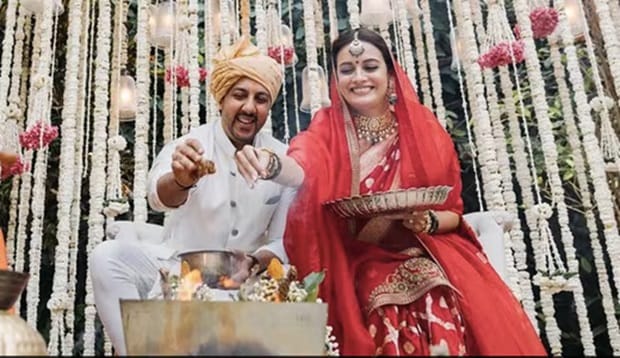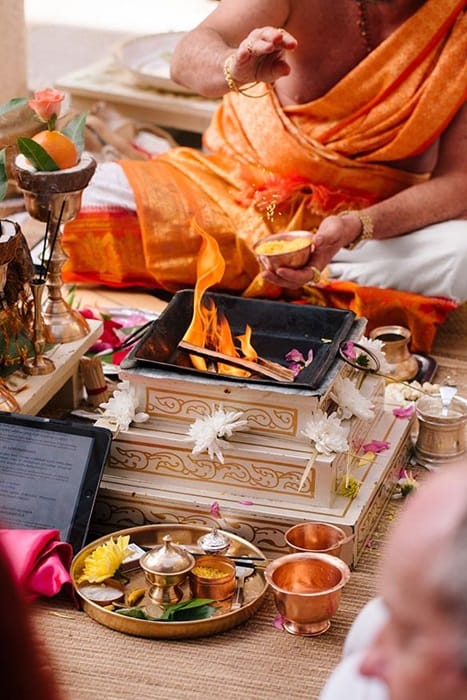Indian Weddings are widely known for their grand celebrations, beautiful decorations, and large feasts. However, their beauty lies in the Vedic wedding rituals that aim to add a special meaning to every aspect of a marital relationship.

All the Vedic rituals have a deep meaning and purpose, connecting the couple to their family and tradition. Read along to learn more about the Vedic wedding rituals and their meaning:
Ganesh Puja
Before the wedding rituals begin, Ganesh puja is conducted to ensure a smooth and joyful wedding. In Vedic culture, Lord Ganesh is worshipped as the remover of obstacles. This ritual invites divine blessings for the wedding ceremony and the couple’s upcoming journey of togetherness.

Haldi
We all know about this ritual and the fun we have during Haldi. But do you know the reason behind celebrating Haldi? Do we have this ritual because turmeric is known for its healing properties? Not entirely. People use it during weddings to ward off negative energies.

Kanyadaan
During Kanyadan the bride’s father gives her away to the groom. However, this is symbolic. It symbolizes the bride leaving her father’s clan to join her husband’s dynasty. In the Vedic era, this ritual symbolized the bride’s acceptance by the groom with respect, equality, and dignity.

During this ritual, the bride’s left hand is placed on top of the right hand of her soon-to-be husband while her parents chant the Vedic mantras. This chant removes the shadows of the bad karma from them and absolves their debts to their forefathers.
Special Anectdote
However, with time, things changed. The rise of class, caste, and gender inequality transformed the meaning of this ritual as girls were started being treated as “burden.”
Thus, many women couldn’t accept the giving away or “gifting away” concept and ditched the ceremony because they believed it to be a regressive ritual.

Even the Allahabad High Court had stated that under the Hindu Marriage Act, Kanyadaan isn’t mandatory for a marriage to be successful. Thus, celebrities like Dia Mirza conducted her wedding without the Kanyadaan ritual.
Panigrahana
During this ritual, the bride’s father places his daughter’s hand on the groom’s. With this, the groom accepts the bride as his life partner. By accepting the “pani” or hand of the bride, the groom promises to support her emotionally, physically, and spiritually.

Through this ceremony, the groom announces to the four deities, Bhagya, Aramya, Savita, and Purandhi, that he accepts his responsibilities towards her. This gesture shows the beginning of their shared responsibilities as husband and wife.
Homa
Homa is a sacred fire ritual common in various Vedic ceremonies. In Vedic weddings, Homa represents purity, truth, and divine presence. During Homa, a holy fire is lit, and the priest offers ghee, herbs, and grains while chanting Vedic mantras.

People believe that the fire of the “Homa Kunda” carries the vows taken by the couple to the Gods as witnesses to their promises of togetherness.
Saptapadi
Saptapadi, also known as Pheras, stands for the oaths by the couple during their wedding ceremony. The couple walks around the sacred fire and takes the seven Pheras, representing the seven aspects of married life.
The couple promises to provide for each other, stand by each other’s side, work together towards prosperity, share their happiness, raise a strong family, care for each other’s well-being, and remain lifelong companions.

This ritual is the most crucial part of the Vedic wedding ceremony. After this, the couple is officially considered married.
Ashirwad
After the wedding ritual, the couple seeks blessings from the elders. It is believed that their blessings will guide the newlyweds in their journey of togetherness and fill their lives with prosperity and joy.

Arundhati Nakshatra
The groom shows her bride the star couple Arundhati and Vashishta with the hope of having an ideal marriage. These two stars symbolize a perfect couple, cherishing loyalty and an ideal marital relationship.

Conclusion
Vedic rituals bring harmony, balance, and divine grace as the couple embarks on their lifelong journey together. They cherish the sense of duty, respect, and partnership between the couple, which they nurture with love, patience, and understanding.

So, the next time you attend a wedding ceremony, you know how deep and meaningful these rituals are!



